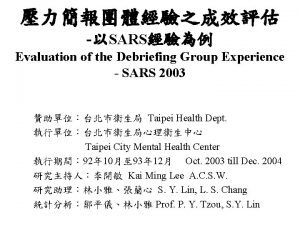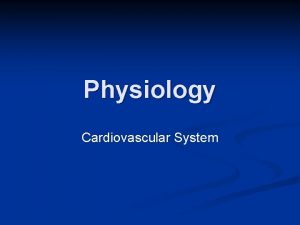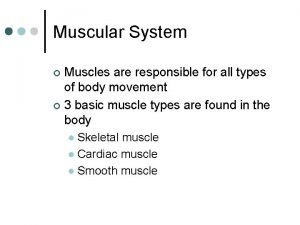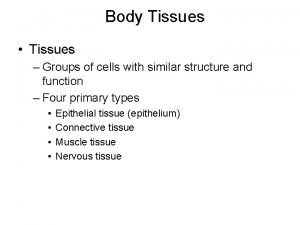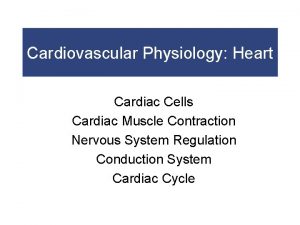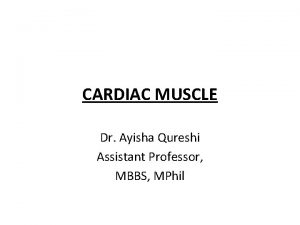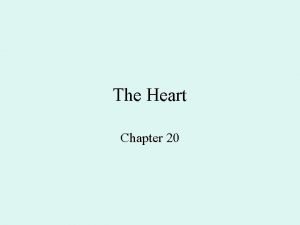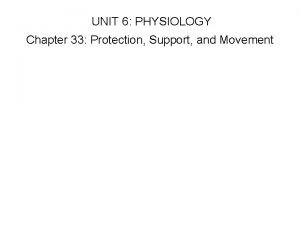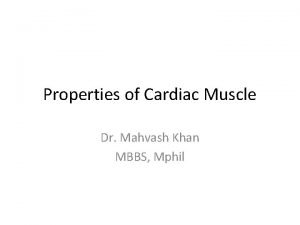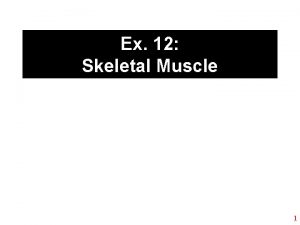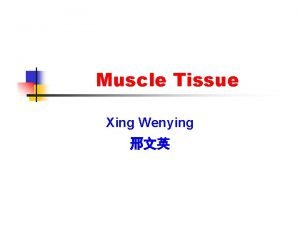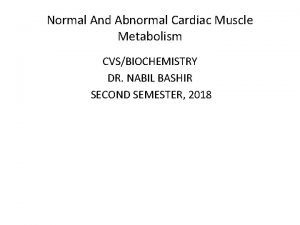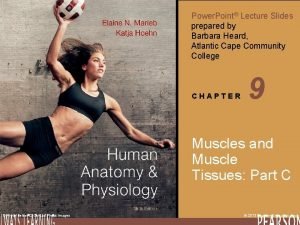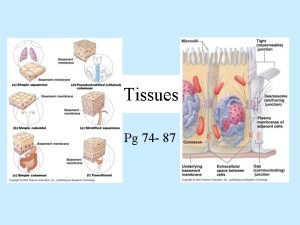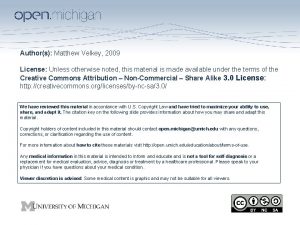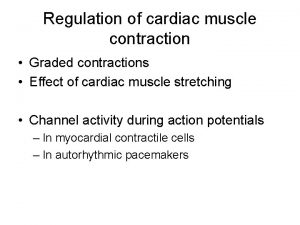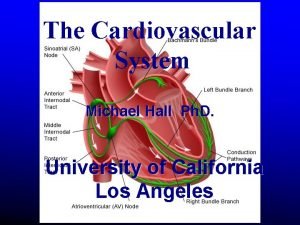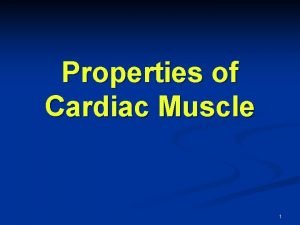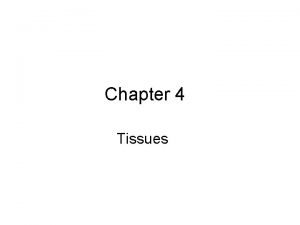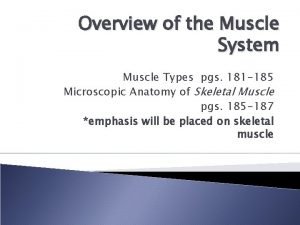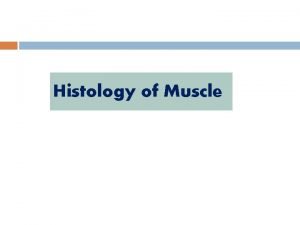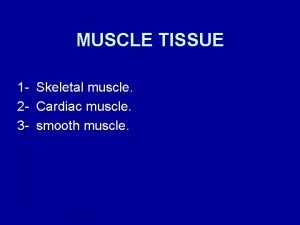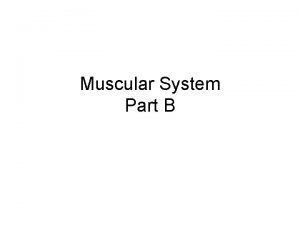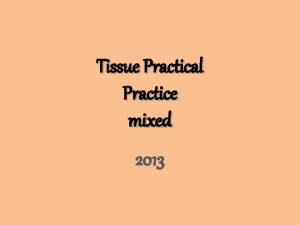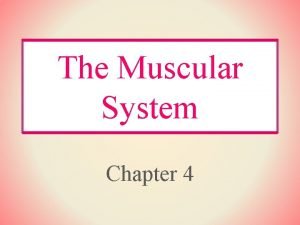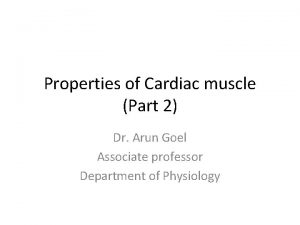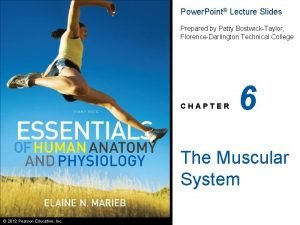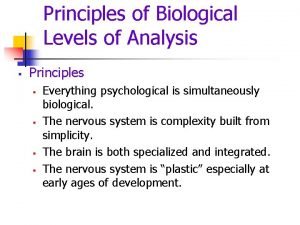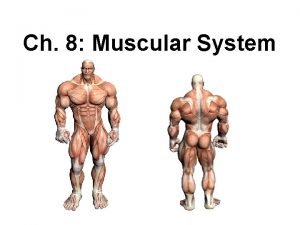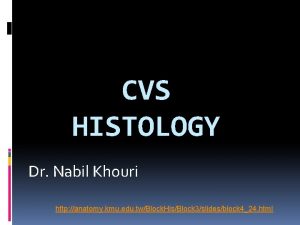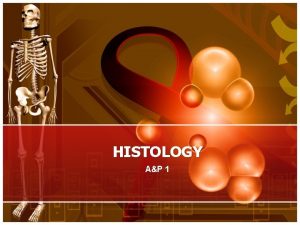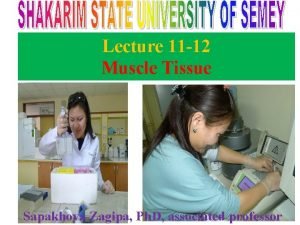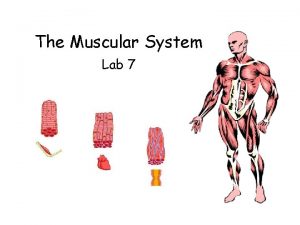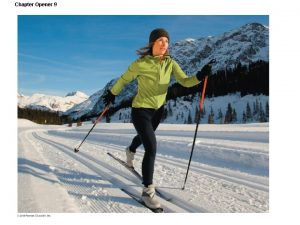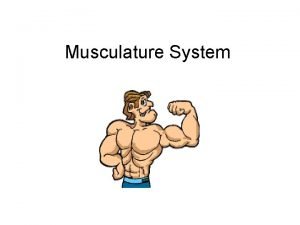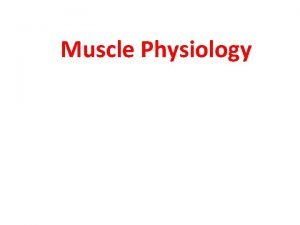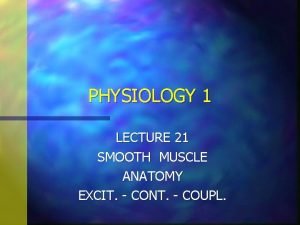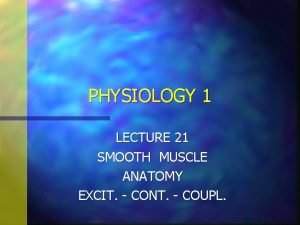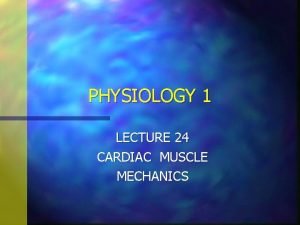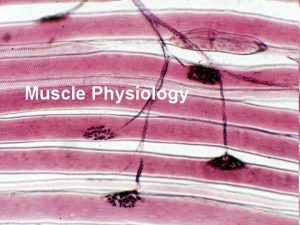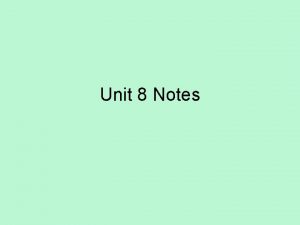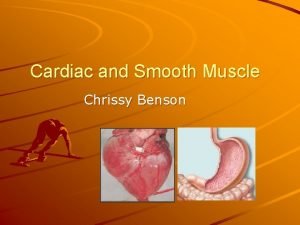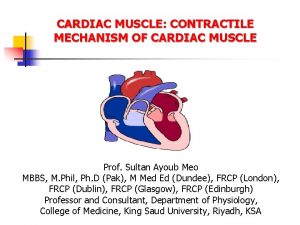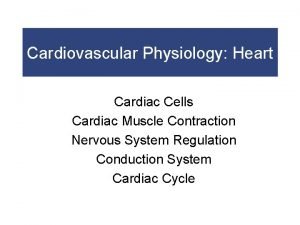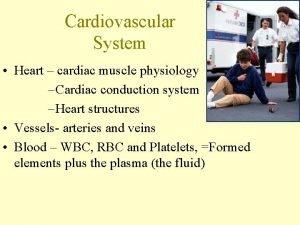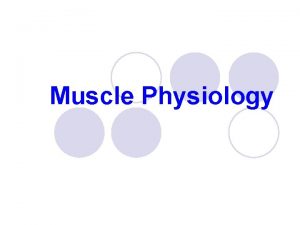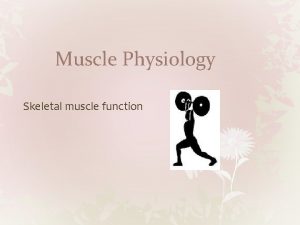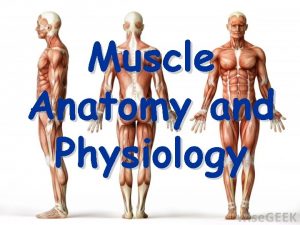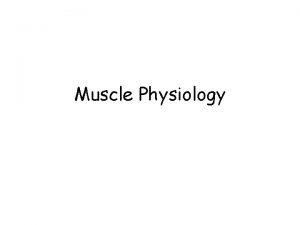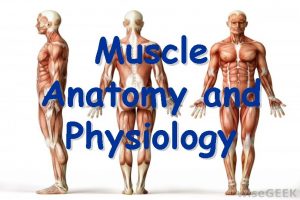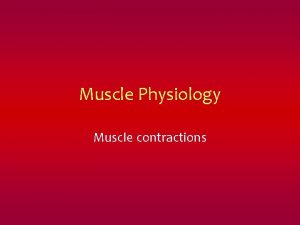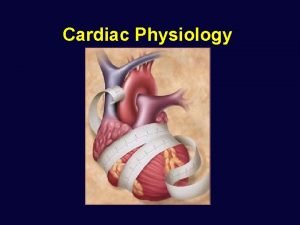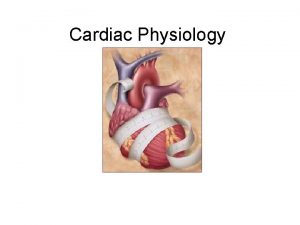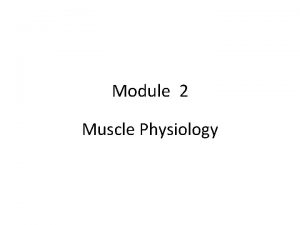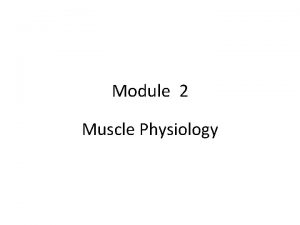PHYSIOLOGY 1 LECTURE 23 CARDIAC MUSCLE EXCIT CONT





































- Slides: 37

PHYSIOLOGY 1 LECTURE 23 CARDIAC MUSCLE EXCIT. - CONT. - COUPL. ACTION POTENTIALS

Cardiac Muscle n Cardiac muscle differs from both smooth muscle and skeletal muscle, being somewhere in between the two. Therefore, cardiac muscle is considered an intermediate form between the more primitive smooth muscle and advanced skeletal muscle. Thus, it has properties of both smooth and skeletal muscle as well as it’s own unique properties.

Cardiac Muscle Structure n n SIZE Cardiac muscle tends to be smaller than skeletal muscle but larger than smooth muscle. About 10 to 15 mm in diameter and around 50 mm in length.

Cardiac Muscle Structure n n Contractile Proteins. In cardiac muscle the contractile proteins are isomers of the skeletal muscle sarcomeres and operate in a similar manner.

Cardiac Muscle Structure n n T- Tubules In cardiac muscle only one T -tubule occurs per sarcomere and Triad formation is somewhat more rudimentary due to the small size of the sarcoplasmic reticulium.

Cardiac Muscle Structure n n Organelles Cardiac muscle is normally mononucleated but a few may be multinucleated. Otherwise organelles are similar to most other cells with the exception of the SR

Cardiac Muscle Structure n The SR in cardiac muscle cells is similar to smooth muscle and takes up less than 5% of cellular volume. Therefore, it lacks space for large amounts of Ca++ and the cell is dependent on external Ca++ for contraction.

Cardiac Muscle Structure n Intercellular Connections - n Cardiac muscle cells are connected by a intercalated disk. In reality these are interdigitated bundles of tightly bound collagen and elastin fibers containing many gap junctions (An electrical syncytium)

Cardiac Muscle Structure n n Sarcomere Size Due to the very heavy quantity of connective tissue surrounding cardiac myocytes the resting sarcomere length is somewhat compressed at 1. 6 m. M.

Cardiac Muscle Structure n There are four types of cardiac muscle histologically “P” cells or pacemaker cells, transition cells, Purkinje cells, and normal cardiomyocytes. All of these are classified as cardiac muscle cells. However the “P”, transition, and Purkinje cells are all part of what is known as the cardiac conduction system and do not participate in muscle contraction but generate and transmit the cardiac action potential.

Cardiac Muscle Structure

Cardiac Muscle Excitation - Contraction - Coupling In cardiac muscle external Ca++ is once again required due to the small volume of the SR. n 1. Calcium induced calcium release n 2. Mechanism of calcium influx n 3. Role of calcium in tension development n 4. Relaxation and calcium efflux n

Cardiac Muscle Excitation - Contraction - Coupling n n Calcium Induced Calcium Release Passage of the cardiac action potential opens the slow calcium/sodium voltage gated channels. Ca++ influx opens Ca++ sensitive calcium channels in the SR.

Cardiac Muscle Excitation - Contraction - Coupling n Mechanism of Calcium Influx - n Calcium will influx through the slow voltage gated channels. But catacholamines also activate c. AMP which in turn activates a c. AMP dependent Protein Kinase which phosphoralates Ca++ channels causing them to open increasing [Ca++].

Cardiac Muscle Excitation - Contraction - Coupling n Role of Ca++ in Tension development - n Increased cytosolic Ca++ concentrations increase crossbridge cycling rates thereby, increasing both the force and speed of myocyte contraction.

Cardiac Muscle Excitation - Contraction - Coupling n Relaxation and Calcium efflux - n Calcium is removed from the cardiac muscle cytosol by our standard Ca++ATPase into the SR and into the interstitial space, but it is joined by a Na+Ca++ exchanger 1 Ca++ out for 3 Na+ in.

Cardiac Muscle Fast Cardiac Action Potential n There are two cardiac action potentials produced by coronary myocytes, the fast AP and the slow AP. The fast cardiac action potential is characterized by containing a plateau phase. We will take up the slow cardiac AP when we discuss the conduction system of the heart.

Cardiac Muscle Fast Cardiac Action Potential n n n n The Fast Cardiac Action Potential Four phases Phase 4 or resting phase Phase 0 Depolarization Phase 1 Phase 2 Phase 3 Repolarization

Cardiac Muscle Fast Cardiac Action Potential n n Refractoriness Due to the long plateau phase ( phase 2) of the fast cardiac action potential the cardiac cells have time to contract before the action potential is finished. Can not generate tetany.

Cardiac Muscle Slow Cardiac Action Potential

CARDIAC MUSCLE MECHANICS Cardiac muscle Length-Tension n In cardiac muscle the resting sarcomere length is 1. 6 mm due to the large amount of connective tissue. This places the resting sarcomere length on the left hand ascending limb of the active tension curve.

CARDIAC MUSCLE MECHANICS Cardiac muscle Length-Tension n The passive tension curve in cardiac muscle begins with the active tension curve and increases rapidly eliminating the right hand descending limb of the active tension curve.

CARDIAC MUSCLE MECHANICS Cardiac muscle Length-Tension n n The cardiac muscle total tension curve then is nearly a straight line steadily increasing. Frank-Starling law of the heart. – Increasing sarcomere length increase force and speed of contraction

CARDIAC MUSCLE MECHANICS Cardiac Load-Velocity Relationship n The isotonic condition -

CARDIAC MUSCLE MECHANICS Cardiac Load-Velocity Relationship n B. Affect of changing afterload (Aortic Pressure or Diastolic Pressure) constant preload

CARDIAC MUSCLE MECHANICS Cardiac Load-Velocity Relationship

CARDIAC MUSCLE MECHANICS Cardiac Load-Velocity Relationship n C. Affect of changing preload - constant afterload

CARDIAC MUSCLE MECHANICS Cardiac Load-Velocity Relationship

CARDIAC MUSCLE MECHANICS Cardiac Contractility n D. Concept of contractility or inotrophy n Contractility or inotrophy is an increase in cytosolic calcium concentration. This phenomenon is under the control of the sympathetic nervous system. As NE is released it activates both the b 1 and a 1 receptors which activate both c. AMP and IP 3 second messengers which cause phosphorylation of calcium channels and thus, increased Ca++ influx. Therefore, more Troponin is activated - > force & Vel.

CARDIAC MUSCLE MECHANICS Cardiac Load-Velocity Relationship

CARDIAC MUSCLE MECHANICS Cardiac Pressure-Volume Loops n Pressure volume loops are an excellent way of illustrating cardiac performance through out the cardiac cycle. They can be used to illustrate contractility, afterload, and preload effects on cardiac performance. The drawback is that they can only be utilized on one side of the heart therefore, the following discussion involves only the left ventricle but the right is similar.





SUMMARY 1. How does cardiac muscle differ from skeletal or smooth muscle? n 2. What is important about cardiac intercalated disks and connective tissue? n 3. What is important about resting cardiac sarcomere length? n 4. What is Frank-Starling’s law of the heart? n 5. What is contractility (inotropy)? n

SUMMARY 6. What is preload, afterload to cardiac tissue? n 7. How does preload or afterload change cardiac performance? n
 Cont or cont'd
Cont or cont'd Debriefing report
Debriefing report Properties of cardiac muscle
Properties of cardiac muscle Elevation muscles
Elevation muscles What type of connective tissue are tendons and ligaments
What type of connective tissue are tendons and ligaments Cardiac output stroke volume and heart rate
Cardiac output stroke volume and heart rate Cardiac muscle
Cardiac muscle Cardiac muscle tissue
Cardiac muscle tissue Factors affecting stroke volume
Factors affecting stroke volume Cardiac muscle mitochondria
Cardiac muscle mitochondria All or none law of cardiac muscle
All or none law of cardiac muscle Fibularis
Fibularis Smooth muscle
Smooth muscle Glycolysis in cardiac muscle
Glycolysis in cardiac muscle Slide
Slide What is a tissue?
What is a tissue? Spleen histology slide labeled
Spleen histology slide labeled Cardiac muscle
Cardiac muscle Cardiac muscle
Cardiac muscle Refractory period in heart
Refractory period in heart General structure of exocrine glands
General structure of exocrine glands Sarcoplasmic
Sarcoplasmic Characteristics of skeletal smooth and cardiac muscle
Characteristics of skeletal smooth and cardiac muscle Properties of cardiac muscle
Properties of cardiac muscle Smooth muscle gap junctions
Smooth muscle gap junctions What tissue is this
What tissue is this The muscular system chapter 4
The muscular system chapter 4 Properties of cardiac muscle
Properties of cardiac muscle Characteristics of skeletal smooth and cardiac muscle
Characteristics of skeletal smooth and cardiac muscle Neural communication
Neural communication Cardiac muscle striations
Cardiac muscle striations Cardiac skeletal and smooth muscle comparison
Cardiac skeletal and smooth muscle comparison Cardiac muscle histology labeled
Cardiac muscle histology labeled Cardiac muscle
Cardiac muscle Features of smooth muscle
Features of smooth muscle Lab 7 the muscular system
Lab 7 the muscular system Comparison of skeletal cardiac and smooth muscle
Comparison of skeletal cardiac and smooth muscle Smooth muscle under the microscope
Smooth muscle under the microscope

